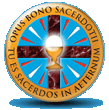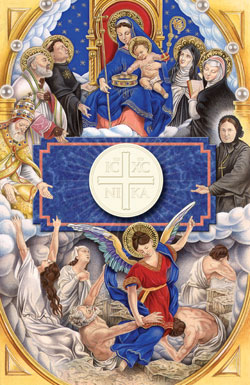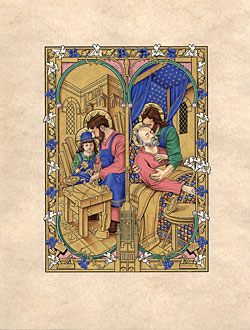
 |
|
|||||
| Opus Bono Sacerdotii | ||||||
| "Work for the Good of the Priesthood" | ||||||
| Network | Recovery Tools | Opus Bono Prayer for Priests | DONATE | |||
| |
| |
| |
| |
| |
| |
| SEARCH: | ||||||
Ciaroscuro: Year in Review: 2009Official Catholic Directory January 1st, 2010 The Year 2009 was one of contrasts. As in painting, where light shines brightest against the darkest background (in Italian, ciaroscuro), so seemed 2009.  The Communion Of Saints, illumination by Chicago-based artist Jed Gibbons. Commissioned by Our Sunday Visitor, Inc. Image: Artist Jed Gibbons. All rights reserved. Yet amid the scuro of 2009, the radiant light of Christ illumined the darkest corners. It took place mostly in hidden ways, and in hidden hearts, which the public will never know. But there were vivid, bold rays of light as well, signs of hope amid suffering. The Communion Of Saints, illumination by Chicago-based artist Jed Gibbons. Commissioned by Our Sunday Visitor, Inc. Image: Artist Jed Gibbons. All rights reserved. Yet amid the scuro of 2009, the radiant light of Christ illumined the darkest corners. It took place mostly in hidden ways, and in hidden hearts, which the public will never know. But there were vivid, bold rays of light as well, signs of hope amid suffering. These bold illuminating rays of 2009 include remarkable feats of heroism such as Captain Sully's landing of a packed airliner in the Hudson River shortly after take-off. Certainly the lives of those passengers and flight crew were unalterably changed! In Rome, Pope Benedict XVI declared A Year for Priests. He released a new and robust social encyclical Caritas in Veritate, and opened wide the doors of welcome to Anglican dioceses and communities wishing to enter into full communion with the Church of Rome. Both Pope John Paul II and Pope Pius XII were declared Venerable. Pope Benedict made an historic and memorable Pilgrimage to the Holy Land and also met with artists in the Sistine Chapel, inviting them to embark on a special mission of beauty. Additionally, a new trend just beginning to surface in the U.S. may be of particular interest to the Church, namely, a new level of lay-driven support for priests and vocations. Below are snapshots of some of these rays of light from 2009, with special emphasis on one, just-under-the-radar emerging trend in the U.S. Chiaro Snapshots:
 "When Evening Comes and Work is Done" "When Evening Comes and Work is Done"Illumination: Jed Gibbons. Commissioned by the Pontifical College Josephinum. Image: Jed Gibbons. All rights reserved. An emerging trend in the U.S. Lay-driven support for priests. The Serra Club, founded in 1934 and named after Spanish missionary Blessed Junipero Serra, "to foster, affirm and promote vocations to ministry in the Catholic Church," remains today one of the most prayerful and practical lay-driven priest and vocation support organizations in the U.S. and in the world. Yet in 2009, several new lay ministries and outreaches, and one intensive leadership training program, point to an emerging trend of lay-led support for priests. In each of these new ventures, lay founders drew from professional expertise to address festering "occupational challenges" inherent in today's priestly responsibilities. Good Leaders, Good Shepherds program of the Catholic Leadership Institute www.CatholicLeaders.org: Clearly at the helm of the new trend toward lay-initiated support for priests, especially in terms of its goals, content, impact and results, this program has been more than five years in development. In 2009, the first 600 graduates emerged from the institute's unique, two-year leadership curriculum for priests. Current enrollment includes an additional 600 priests and 36 bishops, representing a total of 44 dioceses. By the end of 2010, Fr. Bill Dickinson, National Director of Leadership Development for the Catholic Leadership Institute, estimates that more than one-third of the dioceses in the U.S. will have had, or will be enrolled in, the two-year Good Leaders, Good Shepherds program. "Our mission is to help priests recognize their God-given potential and develop their leadership skills so they can effectively and confidently lead their faith communities in carrying out the mission of Jesus Christ and the Catholic Church," says Fr. Bill Dickinson, national director of leadership development for the Catholic Leadership Institute. "In the priesthood there are three offices that come with ordination," Fr. Dickinson explains, "to teach, to sanctify and to govern. We made a choice with this program to support the governing office because it's the leadership component and very little is done to support it." "We have a different program for bishops," says Fr. Dickinson, adding that four bishops have opted instead to go through the priest program with their priests. There is a supporting lay version of the curriculum, accessible only to graduate priests who may choose and recommend key lay associates to attend this program. This development of this program, built from the ground-up with priests in mind, underscores the new trend to put lay expertise at the service of the priests. Dick Lyles, CEO of a global consulting firm, Leadership Legacies, CEO of a Hollywood film-making company, Origin Entertainment, host of The Catholic Business Hour, and author or co-author of more than eight business and leadership books, has literally traveled the world delivering management consulting and training to companies such as Pfizer, Hughes Aircaft, Exxon, Wendy's, the New Zealand Dairy Board, Ericsson, and many others. He is the principal developer of the Good Leaders, Good Shepherd curriculum, and of its accompanying book with the same title. Using Jesus Christ as the ultimate shepherd and model of leadership, Mr. Lyles explains, the curriculum for clergy was specifically designed to help priests overcome the challenges today of a diminishing number of clergy and more complex circumstances for priestly ministry. The goal is to minimize the frustration and energy spent on their administrative roles and maximize the joy and time spent on the pastoral duties for which they were uniquely ordained. The impact will be more holy, healthy, and happy shepherds of vibrant parish communities, leading more people to a deeper relationship with Christ. "The results are truly transformative for priests and parishes," says Mr. Lyles. "We didn't just take a business model and give it a priestly focus. Instead, we developed this program from the ground up to meet the unique demands, challenges and responsibilities of a priest, especially a parish priest. That involved a lot of first-hand research with priests and pastors." Because the institute's program heralds this new trend, it has been operating enough so that the impact on priests and parishes is more evident than other initiatives. Of all the feedback gathered, perhaps the most significant were the reactions of priests in the first classes. "In every class I taught, especially at the end of the first module, I'd have a few priests come up to me with tears in their eyes, saying they couldn't believe that someone cared enough about them to put together a program of this caliber and quality. Every class was like that," said Mr. Lyles, who was heavily involved in training during the first years of the program. "One priest told me that he used to walk down the street as a priest and everyone would say ‘hi,' welcome him and be positive. But now he walks down the street and people turn away! …Another priest told me, again with tears in his eyes, that this curriculum has changed his whole attitude about himself, just to know someone cared this much about him…. I heard so many comments from priests like this; ‘You can't imagine what it means to me that someone would put something like this together for me, for priests!' ‘Thank you for putting something together of this quality to help me be better in what I do.'" Interviewed priests concur: Fr. Brian Smith, from the Archdiocese of Boston, is Parochial Vicar at St. Edith Stein Parish. He says, "I would tell any priest, ‘You need it more than you think; you'll benefit from Good Leaders, Good Shepherds in ways you cannot imagine…the objectivity it brings is literally invaluable." "I feel that I am better able to read and relate to people, and that I have a system to better understand where others are coming from," agreed Fr. Michael Phillippino, a pastor from the Diocese of Norwich. "The program gives me a greater advantage in being a more effective priest and evangelizer." "I found GLGS to be a high level program which takes seriously God's call for priests to act responsibly as leaders. If leading souls to Christ is the call of the priest, then GLGS provides a way to do this with confidence and competence…Leadership skill building founded on a solid understanding of one's own behavior, and that of others, is a great contribution," says Fr. Bill Kelly, Director, Clergy Support Office, for the Archdiocese of Boston. In the words of one lay person in California who wished to remain anonymous, "Imagine the transformative effect of this leadership training on parishioners and parish communities, in a myriad of parishes nationwide, whose pastors begin to lead their flocks with confidence, clarity of vision and joy in his uniquely priestly ministry." "Hopefully," adds Mr. Lyles, "this is the beginning of an effort by lay people who will rise up to support their priests in tangible ways." The same year that Catholic Leadership Institute celebrated its first priest graduation class, a handful of other developments echo this trend of lay persons formalizing their professional expertise at the service of priests.  Vocation Boom is a team of passionate advocates dedicated to supporting the priesthood as a life's vocation and mission. www.VocationBoom.org www.VocationBoom.org is an interactive website with multiple resources for men who are discerning a priestly vocation. Although formally launched in 2009, it is the fruit of more than 20 years of prayer and deliberation. The initiative was founded by Jerry Usher, a pioneer of the recent growth in Catholic Radio over the past decade, and also a young man who spent time discerning his own vocation, especially during a time of priestly formation from 1989 to 1995. VocationBoom.org, with its energy and functionality, clearly reflects full use of this era's new media tools, with easy opportunities for users to connect via blog comments, Twitter, FaceBook and YouTube. The site also is new in its approach. It reflects the vantage point of a person searching, and leads with the kinds of questions and curiosity of today's young man. And it does so in a warm, inviting and simple way; it speaks his language. Vocation Boom is a team of passionate advocates dedicated to supporting the priesthood as a life's vocation and mission. www.VocationBoom.org www.VocationBoom.org is an interactive website with multiple resources for men who are discerning a priestly vocation. Although formally launched in 2009, it is the fruit of more than 20 years of prayer and deliberation. The initiative was founded by Jerry Usher, a pioneer of the recent growth in Catholic Radio over the past decade, and also a young man who spent time discerning his own vocation, especially during a time of priestly formation from 1989 to 1995. VocationBoom.org, with its energy and functionality, clearly reflects full use of this era's new media tools, with easy opportunities for users to connect via blog comments, Twitter, FaceBook and YouTube. The site also is new in its approach. It reflects the vantage point of a person searching, and leads with the kinds of questions and curiosity of today's young man. And it does so in a warm, inviting and simple way; it speaks his language. Among the website's opportunities to share experiences and questions, a user will find first-hand examples and true stories of others discerning the same vocation. Likewise, there are links to vocation directors, church teachings, the next steps along the discernment process, and much more. In short, a young man seeking to determine his vocation to the priesthood would feel he is not alone in the journey. "We're building a culture that's open to the priesthood, clearing the path to discovery, and unlocking hearts and minds to God's call," says Mr. Usher, whose site is not limited by locality or priestly options (religious order, diocesan, etc.) Although spearheaded by Mr. Usher, development of the site and its growing set of tools and resources have been two years in development with the founder's colleagues. As he puts it: "Pope Benedict XVI's recent proclamation of The Year for Priests is a confirmation of our intentions and an indication that now is the time to unveil Vocation Boom!" www.EncouragePriests.org A third initiative, still in its infancy, was just launched in April 2010 by Tom Peterson, founder of Catholics Come Home (www.CatholicsComeHome.org), a nonprofit media apostolate dedicated to producing and airing television ads encouraging Catholics to "come home" to the Church if they have been away. EncouragePriests.org is a communications outreach of Catholics Come Home, Inc. According to the website, its mission is "to encourage priests, and promote priestly vocations through our love and prayers." Television commercials that showcase the humanitarian efforts of priests are slated to begin production and airing in the near future. By June 2010, the organization plans to launch an improved, interactive website enabling Catholics to offer spiritual bouquets, e-cards, printable greeting cards, video messages and blogs with "kind words of gratitude to show appreciation for countless priests around the world." "Countless priests deserve our true gratitude and love, as so many lead sacrificial and humble lives," says Mr. Peterson, the former CEO of an advertising agency in Phoenix. "These noble men of God need our encouragement and could be uplifted by a simple prayer and a gentle word of appreciation from us." These lay-driven initiatives indirectly follow on the heels of scattered prayer initiatives for priests and one particularly notable ministry to priests in crisis called Opus Bono Sacerdotii, Work for the Good of the Priesthood, (www.OpusBono.com). "We've helped about 5,000 priests in crisis in the last eight years," says Opus Bono Sacerdotii founder Joe Maher, a former turnaround CEO who launched his career in the Hollywood entertainment industry and segued to Fortune 500 companies by request. Several years after he relocated his family to the Midwest a local priest was in crisis and needed help. Mr. Maher applied his professional expertise to the situation and his nonprofit apostolate grew from there, ultimately demanding his full commitment. "We still deal with thousands of priests," Mr. Maher adds. "We work as quietly as we can, since everything we do with a priest is confidential. We now get about a call a day." Although radically different in its focus from the goals of those groups comprising the emerging trend, Opus Bono Sacerdotii nonetheless exemplifies professional lay expertise brought to the service of priests and the priesthood. Where this emerging trend will lead is anyone's guess, but the impact is already quietly seeping into parishes nationwide. KAREN A. WALKER is Editor and Publisher of the Catholic Business Journal and Producer of The Catholic Business Hour radio show. |
|
© Copyright 2002-2010 Opus Bono Sacerdotii, an IRS approved 501c3 corporation, all contributions are tax deductible in the USA.
Please do not hesitate to contact us if you have questions about the site.